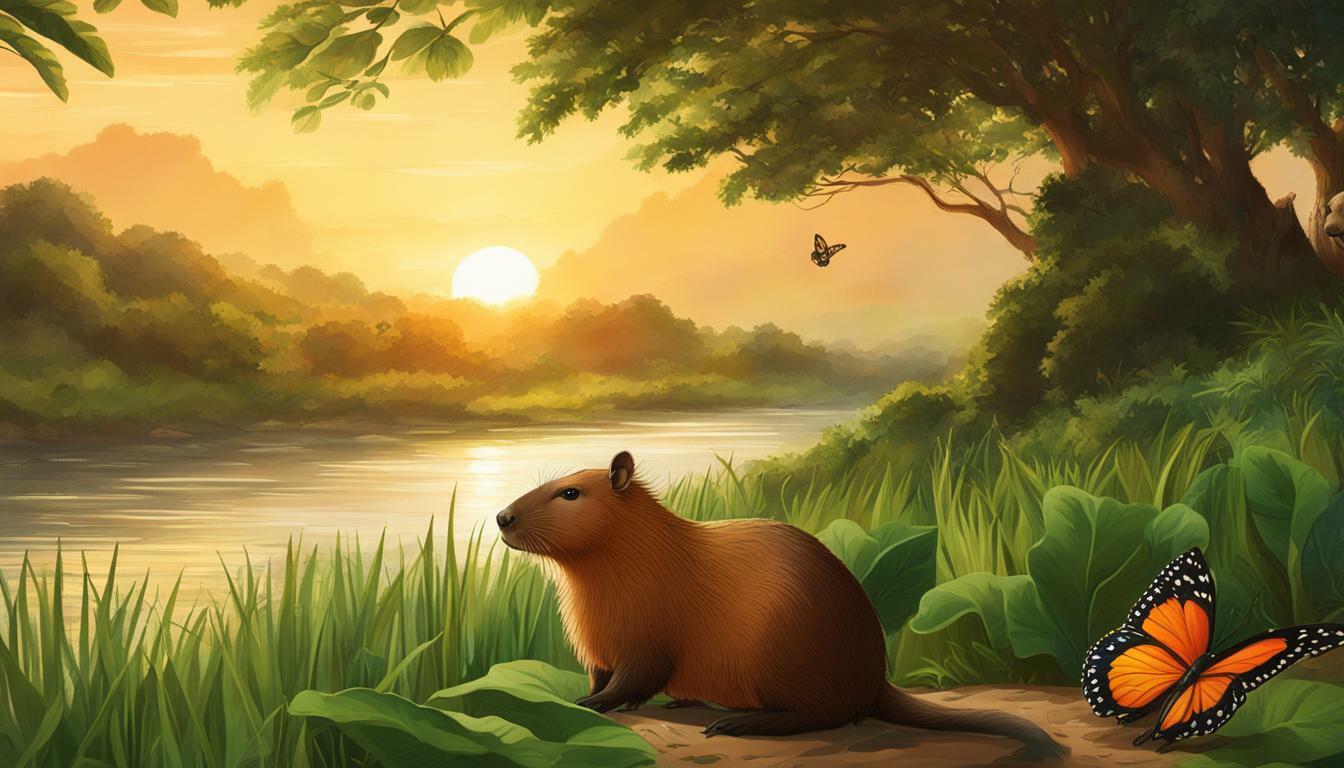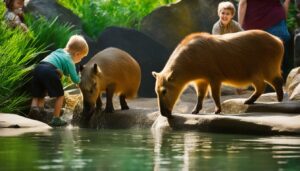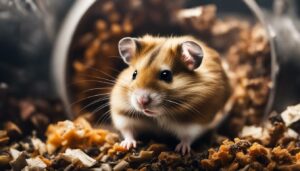Capybaras have a lifespan that varies depending on various factors. These fascinating creatures, known as the world’s largest rodent, can grow up to 106-134cm in length and weigh between 35-66kg. With their semi-aquatic nature, capybaras are adept at both land and water activities, able to swim and hold their breath for up to 5 minutes.
Being herbivores, capybaras primarily feed on grasses and aquatic plants, but they also consume fruits and tree bark. In the wild, they live in social groups of 10-20 individuals, displaying their highly sociable nature. However, capybaras face predation from formidable predators such as jaguars, pumas, caimans, and green anacondas.
On average, capybaras live for 8-10 years in the wild. However, in captivity, they have been known to live up to 12 years. Their lifespan can be influenced by various factors, including their environment, care, and predation risks.
Key Takeaways:
- Capybaras have a lifespan of 8-10 years in the wild.
- They are the world’s largest rodent, growing up to 106-134cm in length and weighing 35-66kg.
- Capybaras are semi-aquatic and can swim and hold their breath for up to 5 minutes.
- They are herbivores, feeding on grasses, aquatic plants, fruits, and tree bark.
- Capybaras live in social groups of 10-20 individuals and are highly sociable.
- Predators such as jaguars, pumas, caimans, and green anacondas pose threats to capybaras.
- In captivity, capybaras can live up to 12 years.
Capybara Lifespan in the Wild
In the wild, capybaras typically live for 8-10 years, but this can be influenced by several factors. These factors include predation, habitat conditions, and availability of food and water sources. Capybaras are preyed upon by predators such as jaguars, pumas, caimans, and green anacondas, which can significantly affect their lifespan.
Being the world’s largest rodent, capybaras have a size advantage that helps them defend against predators to some extent. However, their lifespan can still be shortened if they fall victim to predation. The availability of suitable habitats with ample food and water also plays a crucial role in their survival. Capybaras are semi-aquatic and highly dependent on water sources for drinking, swimming, and finding food. A lack of access to water can negatively impact their lifespan.
Another important factor that can influence capybara lifespan in the wild is the availability of food sources. Capybaras are herbivores and primarily feed on grasses and aquatic plants. However, they can also consume fruits and tree bark. The abundance and quality of these food sources can vary depending on the season and environmental conditions. A lack of sufficient food can weaken capybaras, making them more susceptible to diseases and reducing their lifespan.
In summary, the lifespan of capybaras in the wild is typically around 8-10 years, but it can be shorter if they are preyed upon by predators, face habitat challenges, or experience food scarcity. These factors highlight the delicate balance between survival and the challenges capybaras face in their natural environment.
Capybara Longevity in Captivity
Capybaras can live longer when kept in captivity, with some individuals reaching up to 12 years of age. Compared to their wild counterparts, the extended lifespan of captive capybaras can be attributed to several factors.
In a controlled environment, capybaras are protected from natural predators and have access to a consistent food supply, which can contribute to their overall health and wellbeing. Additionally, veterinary care and nutritional supplements provided in captivity can help address any health issues that may arise, further extending their lifespan.
Furthermore, the social structure of capybaras is also an important consideration. In the wild, capybaras live in groups and thrive on social interaction. When kept in captivity, efforts are made to replicate this social dynamic by housing capybaras in groups or pairs. This socialization not only provides mental stimulation but also helps to reduce stress, ultimately promoting their longevity.
| Factors | Effect on Capybara Longevity |
|---|---|
| Protection from predators | Increases lifespan by eliminating predation risk |
| Consistent food supply | Ensures proper nutrition, leading to improved health and longevity |
| Veterinary care and supplements | Addresses health issues, enhancing overall wellbeing and extending lifespan |
| Socialization | Promotes mental stimulation, reduces stress, and contributes to a longer life |
In conclusion, capybaras have the potential to live longer in captivity due to factors such as protection from predators, access to a consistent food supply, veterinary care, and socialization. These factors combine to create a conducive environment for capybaras to thrive and reach their maximum lifespan of up to 12 years. The successful care and management of capybaras in captivity contribute to their longevity, allowing us to appreciate and learn more about these fascinating creatures.
Maximum Lifespan of Capybara
While the average lifespan of capybaras is around 8-10 years, there have been instances of individuals living beyond this range. These exceptional cases demonstrate that capybaras can live longer under certain conditions, whether in the wild or in captivity.
In the wild, capybaras face numerous challenges that can impact their lifespan. Predation is a major threat, with predators such as jaguars, pumas, caimans, and green anacondas hunting capybaras for food. Those that manage to avoid predation and maintain a healthy diet and lifestyle can live longer.
When kept in captivity, capybaras have the potential to live longer due to the absence of predators and access to a controlled diet and environment. It is not uncommon for captive capybaras to live up to 12 years. This extended lifespan is a testament to the benefits of providing suitable care and ensuring the capybaras’ physical and emotional well-being.
It’s important to note that the maximum lifespan of capybaras is influenced by various factors, including genetics, environment, diet, and overall health. By understanding these factors and providing optimal conditions, we can help capybaras live longer, healthier lives. However, it’s essential to remember that each capybara is unique, and individual lifespans may vary.
| Maximum Lifespan of Capybara | |
|---|---|
| Wild | 8-10 years |
| Captivity | Up to 12 years |
Capybara Lifespan Comparison
The lifespan of capybaras falls within the range observed for similar-sized mammals. When comparing the average lifespan of capybaras to other animals, it is clear that they have a relatively short lifespan. In the wild, capybaras typically live for 8-10 years, which is similar to other large rodents such as beavers and porcupines. However, when compared to smaller rodents like mice and rats, capybaras have a significantly longer lifespan.
One interesting comparison to note is with domesticated guinea pigs, which are closely related to capybaras. Guinea pigs have an average lifespan of 4-7 years, which is shorter than their larger counterparts. This difference in lifespan may be attributed to the variations in their natural habitats and the level of predation they experience.
It’s important to consider that lifespan can also be influenced by factors such as diet, environment, and genetics. Capybaras are herbivores and their diet mainly consists of grasses and aquatic plants. This specialized diet may contribute to their relatively short lifespan compared to carnivorous or omnivorous animals. Additionally, predation plays a significant role in the lifespan of capybaras. They are preyed upon by predators such as jaguars, pumas, caimans, and green anacondas, which can impact their survival rate in the wild.
| Animal | Average Lifespan | Size |
|---|---|---|
| Capybara | 8-10 years | 106-134cm, 35-66kg |
| Beaver | 10-15 years | 74-90cm, 16-32kg |
| Porcupine | 10-15 years | 60-90cm, 5-32kg |
| Mouse | 1-3 years | 5-10cm, 10-40g |
| Rat | 1-3 years | 15-40cm, 100-500g |
| Guinea Pig | 4-7 years | 20-40cm, 500-1500g |
In conclusion, capybaras have a relatively short lifespan compared to other animals of similar size. While they may not live as long as smaller rodents, their lifespan falls within the range observed for mammals of their size. Factors such as diet, predation, and habitat can all contribute to the variations in lifespan observed among different species. Understanding these factors is crucial in the field of wildlife conservation and the preservation of capybara populations.
Understanding Capybara Life Cycle
The life cycle of a capybara encompasses different developmental stages that contribute to their lifespan. These fascinating creatures go through a series of transformations as they grow and adapt to their environment. Understanding their life cycle can provide valuable insights into their behavior, habitat requirements, and overall longevity.
Let’s take a closer look at the stages of a capybara’s life cycle:
- Birth: Capybaras are born fully furred and with their eyes open. They are precocial animals, which means they are relatively independent from birth and can start grazing on vegetation within a few days. However, they still rely on their mothers for protection and guidance during the early stages of life.
- Adolescence: As capybaras mature, they go through an adolescent phase where they develop their social skills and establish their place within the group hierarchy. They become more independent and begin exploring their surroundings, venturing further away from their mothers.
- Adulthood: Once capybaras reach adulthood, they are ready to reproduce. Males compete for the attention of females through displays of dominance and vocalizations. Successful males will form mating bonds with females, and the gestation period lasts around 150 days, resulting in the birth of a litter of 2-8 pups.
- Socialization: Capybaras are highly social animals and live in large groups known as herds. Socialization is a crucial aspect of their life cycle, as it helps them establish strong bonds within the group, provides protection against predators, and enhances their overall survival.
Throughout their life cycle, capybaras face various challenges that can influence their lifespan. Predation, habitat quality, availability of food and water, and disease are all factors that can impact their longevity. Furthermore, their size, social structure, and the specific environment they inhabit can also play a role in determining their life expectancy.
| Developmental Stage | Average Lifespan |
|---|---|
| Birth to Adolescence | 1-2 years |
| Adulthood | 6-8 years |
| Total Lifespan | 8-10 years in the wild 12+ years in captivity |
“The life cycle of a capybara is a fascinating journey of growth, socialization, and adaptation. From their early days as independent grazers to their role in the dynamic dynamics of a herd, these unique creatures are constantly evolving throughout their lives. By understanding their life cycle, we gain a deeper appreciation for the complexity of their existence and the challenges they face in the wild.”
Influences on Capybara Longevity
The longevity of capybaras can be affected by various factors, both internal and external. Understanding these influences is crucial for ensuring the well-being and survival of these fascinating creatures. Let’s explore some of the key factors that can impact the lifespan of capybaras.
1. Predation: Capybaras are natural prey for predators such as jaguars, pumas, caimans, and green anacondas. The risk of predation can significantly shorten their lifespan, as these predators are known to target capybaras, especially the young and vulnerable ones.
2. Habitat: The environment in which capybaras live plays a vital role in their longevity. Capybaras thrive in wetlands and semiaquatic areas, as they are excellent swimmers and rely on water for regulating their body temperature. Disruption or loss of their natural habitat can have detrimental effects on their lifespan.
3. Nutrition: Adequate nutrition is essential for the health and longevity of capybaras. They are herbivores and primarily feed on grasses and aquatic plants. A varied and balanced diet ensures that they receive all the necessary nutrients, vitamins, and minerals. Poor nutrition can weaken their immune system and make them more susceptible to diseases and infections.
Internal Factors
Certain internal factors can also influence the lifespan of capybaras. These include genetics, individual health, and reproductive success. Genetic predispositions, such as susceptibility to certain diseases or physiological conditions, can impact their overall health and lifespan. Additionally, a capybara’s ability to reproduce successfully can affect its longevity, as successful reproduction contributes to the survival of the species.
It is important to note that while these factors can influence capybara longevity, there are exceptions to every rule. Some capybaras may live longer than average due to favorable circumstances, while others may have their lifespan cut short due to unfortunate events or health issues.
In summary, the longevity of capybaras is subject to various influences, both internal and external. Predation, habitat conditions, nutrition, and individual factors all play a role in determining the lifespan of these remarkable creatures. By understanding and addressing these influences, we can contribute to the conservation and well-being of capybaras in their natural habitats and in captivity.
| Factors Affecting Capybara Longevity | External Factors | Internal Factors |
|---|---|---|
| Predation | Habitat | Genetics |
| Habitat | Nutrition | Individual Health |
| Nutrition | Reproductive Success |
Capybara Size and Lifespan
When it comes to capybaras, size doesn’t necessarily dictate lifespan. There is no significant correlation between the size of capybaras and how long they live. These fascinating creatures, known as the world’s largest rodents, can grow up to an impressive length of 106-134cm and weigh anywhere from 35-66kg.
Although capybaras vary in size, their average lifespan remains relatively consistent. In the wild, capybaras typically live for 8-10 years, while those in captivity have been known to reach up to 12 years. It’s important to note that these are averages, and individual capybaras may exceed or fall short of these numbers.
While size may not directly affect a capybara’s lifespan, there are other factors to consider. These social animals thrive in groups of 10-20 individuals and are highly adapted for both land and water environments. Capybaras can swim effortlessly and hold their breath for up to 5 minutes, enabling them to navigate their semi-aquatic habitat with ease.
As herbivores, capybaras primarily feed on grasses and aquatic plants. However, they are also known to consume fruits and tree bark, demonstrating their adaptability to various food sources. Despite their adaptability, capybaras face threats from predators such as jaguars, pumas, caimans, and green anacondas, which can impact their average lifespan in the wild.
| Average Lifespan: | 8-10 years (wild) | Up to 12 years (captivity) |
|---|---|---|
| Size Range: | 106-134cm (length) | 35-66kg (weight) |
| Diet: | Grasses, aquatic plants, fruits, tree bark | |
| Social Structure: | Groups of 10-20 individuals | |
| Main Predators: | Jaguars, pumas, caimans, green anacondas |
Capybaras as Prey and Lifespan
Predation plays a significant role in the lifespan of capybaras in the wild. As the world’s largest rodent, capybaras are a sought-after meal for a variety of predators, including jaguars, pumas, caimans, and green anacondas. These predators pose a constant threat to capybaras, especially the young and weaker individuals.
The constant pressure from predators means that capybaras must constantly be on the lookout for danger. Their highly social nature plays a crucial role in their survival, as living in large groups provides them with safety in numbers. When one capybara detects a predator, it can alert the rest of the group, allowing them to escape and potentially reduce the risk of being captured.
However, despite their vigilance and group dynamics, capybaras still fall victim to predation. This, in turn, can have a significant impact on their lifespan in the wild. The average lifespan of capybaras in their natural habitat is around 8 to 10 years, but this can vary depending on the abundance of predators and other external factors.
| Predator | Impact on Capybara Lifespan |
|---|---|
| Jaguars | Jaguars are powerful predators that can easily overpower capybaras, especially during hunting season. Their presence can significantly reduce the lifespan of capybaras in the wild. |
| Pumas | Pumas are stealthy and agile predators that can take down capybaras with ease. They primarily target the young and weak capybaras, further impacting their overall lifespan. |
| Caimans | Caimans are semi-aquatic predators that pose a threat to capybaras when they are in the water. With their sharp teeth and strong jaws, caimans can cause fatal injuries, reducing the lifespan of capybaras in their natural habitat. |
| Green Anacondas | Green anacondas, the largest snake species in the world, are known to prey on capybaras. With their constricting ability, they can suffocate capybaras, leading to a shortened lifespan. |
In conclusion, the presence of predators significantly impacts the lifespan of capybaras in the wild. Despite their social nature and group dynamics, capybaras are constantly at risk of predation, which can lead to a shorter lifespan compared to their captive counterparts.
Capybara Social Structure and Lifespan
Capybaras’ highly social nature may contribute to their average lifespan. These charismatic creatures live in groups of 10-20 individuals, forming close-knit communities that provide them with protection and support. Within these groups, capybaras engage in various social behaviors, including grooming each other, vocalizing, and even sharing communal burrows for resting.
Being part of a social group helps capybaras to thrive and adapt to their environment. They can rely on their fellow group members to watch out for predators and alert the others to potential dangers. This constant vigilance enhances their chances of survival and contributes to their average lifespan in the wild.
In addition to the benefits of protection, social interactions also play a role in the overall well-being of capybaras. Studies have shown that social bonding and companionship can have positive effects on an individual’s health and stress levels. The emotional support provided by their group members likely contributes to capybaras’ longevity and overall quality of life.
The Importance of Family Bonds
Capybaras prioritize family bonds within their social groups. They exhibit nurturing behavior towards their offspring and maintain strong connections with their relatives. This family structure promotes cooperation and cooperation within the group, which further enhances their chances of survival.
The bond between a mother capybara and her offspring is particularly strong, with the young capybaras relying on their mother for protection and guidance. This level of care and support within the family unit helps ensure the survival and well-being of the next generation of capybaras.
Overall, capybaras’ highly social nature and their ability to form strong bonds within their groups contribute to their average lifespan and make them fascinating creatures to observe and study.
| Key Factors | Average Lifespan |
|---|---|
| Wild Capybaras | 8-10 years |
| Captive Capybaras | Up to 12 years |
Capybara Lifespan in Different Environments
Capybaras adapt to various environments, but their lifespans can be influenced by the specific conditions they inhabit. Understanding how these factors impact capybara longevity helps shed light on their overall life expectancy.
Wetlands: Capybaras thrive in wetland habitats, such as marshes and swamps, where they have abundant access to water for swimming and feeding. The combination of aquatic vegetation and grasses provides them with a diverse diet, resulting in better nutrition and potentially longer lifespans.
Forests: In forested environments, capybaras face different challenges. While they can still find water sources like rivers and lakes, the vegetation may vary, leading to differences in available food resources. However, the forest can provide added protection from predators, potentially increasing their chances of survival.
| Environment | Main Characteristics | Impact on Lifespan |
|---|---|---|
| Wetlands | Abundant water sources, aquatic vegetation, diverse diet | Potential for longer lifespan due to better nutrition |
| Forests | Varying water sources, diverse vegetation | Added protection from predators, potential impact on food resources |
It is worth noting that specific environmental factors within these habitats, such as climate, availability of resources, and predation pressure, can further shape capybara lifespan. For example, in regions where capybaras face intense predation, their lifespans may be shorter compared to areas with fewer predator pressures.
Ultimately, capybaras demonstrate remarkable adaptability to different environments, but their lifespan is subject to the specific conditions they encounter. By examining the interplay between these factors, researchers can gain a better understanding of the influences on capybara longevity and contribute to conservation efforts for this unique species.
Conclusion
Capybaras have an average lifespan of 8-10 years in the wild, although factors such as predation, environment, and social structure can influence their longevity. These fascinating creatures are the world’s largest rodent, growing up to 106-134cm in length and weighing 35-66kg. Capybaras are well-adapted for both land and water, being able to swim and hold their breath for up to 5 minutes.
As herbivores, capybaras primarily feed on grasses and aquatic plants, but they can also consume fruits and tree bark. They thrive in groups of 10-20 individuals and have a highly social nature. However, their vulnerability to predators like jaguars, pumas, caimans, and green anacondas can significantly impact their lifespan in the wild.
In captivity, capybaras have been known to live up to 12 years, thanks to a controlled environment and proper care provided by humans. Comparing their lifespan to other animals, capybaras generally have a relatively short life expectancy. Understanding their life cycle and the influences on their longevity can help us appreciate these remarkable creatures and ensure their conservation in their natural habitats.
FAQ
How long do capybara live?
Capybaras have a lifespan of 8-10 years in the wild. In captivity, they have been known to live up to 12 years.
What is the size of a capybara?
Capybaras are the world’s largest rodent, growing up to 106-134cm in length and weighing 35-66kg.
Are capybaras aquatic animals?
Yes, capybaras are semi-aquatic and are well-adapted for both land and water. They can swim and hold their breath for up to 5 minutes.
What do capybaras eat?
Capybaras are herbivores and mainly eat grasses and aquatic plants. They can also eat fruits and tree bark.
Do capybaras live in groups?
Yes, capybaras live in groups of 10-20 individuals and are highly social animals.
What predators do capybaras have?
Capybaras are preyed upon by predators such as jaguars, pumas, caimans, and green anacondas.




